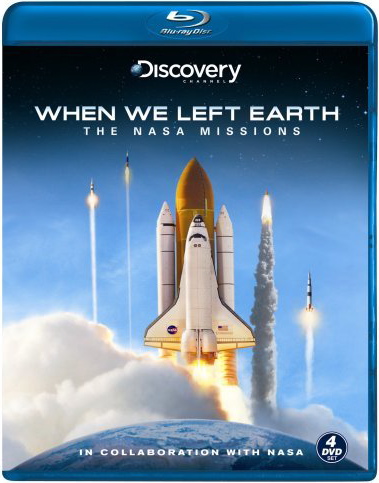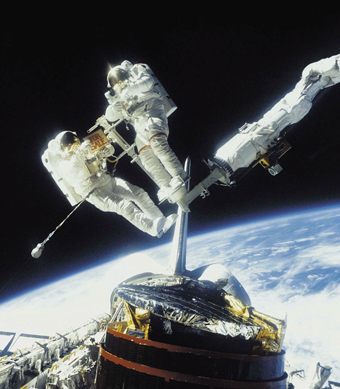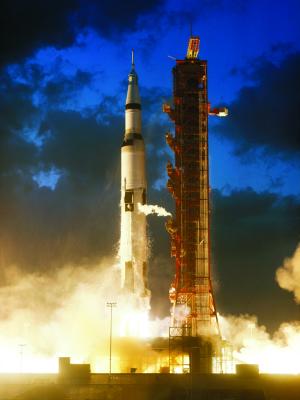| Release List | Reviews | Price Search | Shop | Newsletter | Forum | DVD Giveaways | Blu-Ray/ HD DVD | Advertise |
| Reviews & Columns |
|
Reviews DVD TV on DVD Blu-ray International DVDs Theatrical Reviews by Studio Video Games Features Collector Series DVDs Easter Egg Database Interviews DVD Talk TV DVD Talk Radio Feature Articles Columns Anime Talk DVD Savant HD Talk Horror DVDs Silent DVD
|
DVD Talk Forum |
|
|
| Resources |
|
DVD Price Search Customer Service #'s RCE Info Links |
|
Columns
|
 |
When We Left Earth: The NASA Missions |

|
When We Left Earth: The NASA Missions Blu-ray Discovery Channel / Image 2008 Color 1:78 widescreen 258 min. Street Date September 30, 2008 69.98 Narrated by Gary Sinise |
When We Left Earth: The NASA Missions is a terrific chronicle of the first forty years in space as told by the men and women who flew the missions and ran the programs. Using every resource in NASA's film library, The Discovery Channel has broken the subject into six chapters, telling each phase of America's steps into space in impressive detail.
The producers have pitched the show at an educated audience, illuminating many concepts and delineating some complicated moments of decision in a way that encourages our involvement and emotional participation -- without resorting to sentimental tricks to dramatize events that need no embellishment.

Even better, the long format allows the astronauts to express more of their personal take on these exciting, daring missions. The first test pilots- turned spacemen cop to their competitiveness and egos, qualities that should be expected of daredevils willing to ride atop tons of high explosives. The interviews with ground control personnel convey the professionalism and camaraderie among the support team. When the astronauts express their feelings about their comrades lost in accidents, they hold little back. But the spirit of exploration and adventure dictates that the missions continue. It's inspirational to know that when given a worthwhile goal, men and women are willing to risk everything they have.
The first three discs have two shows each, plus extras. Disc One begins with Ordinary Supermen, the story of the first Mercury astronauts. The training and the awkwardness of these first flights plays quite a bit like The Right Stuff but without the exaggerated humor and gee-whiz talk; the real Mercury 7 are just as interesting as their filmic counterparts. Friends and Rivals tells the story of Gemini, with the space walks and other orbital experiments.
The second disc begins with an almost perfect recounting of the Apollo Missions, Landing the Eagle. The choice of footage is very nostalgic -- we even see a bit of the way the landings looked on our home televisions, with the words "Live from Moon" written on the bottom of the screen. It's fascinating to find out that as Neil Armstrong and Buzz Aldrin were descending to the moon's surface, computer warnings were going off back in mission control. Armstrong used all of his fuel reserves and only found a safe landing place at the last minute. The Explorers shows the other Moon missions and the Skylab experiments. Its highlight is the true story of what almost became a disaster in space, the nail-biting saving of the Apollo 13 mission, when a fuel tank blew up on the way to the moon.

Disc Three takes on The Shuttle, from tests in 1977 to its great successes to the catastrophic disaster in 1986, covered in full detail. The NASA personnel do not hide the fact that the agency had become arrogant and negligent when it insisted on taking off in freezing temperatures -- even the distraught relatives in the reviewing stand are obviously concerned that something will go wrong. 1 A Home In Space chronicles the missions that construct the space station, cooperation with the Soviets and the second Shuttle accident. The show ends on a positive note, preferring not to discuss moon and mars missions compromised by our country's present financial troubles.
Each disc carries uncut "mission clips", interviews with key personnel and excerpts from NASA films through the history of the agency. Disc Four contains a broad selection of complete NASA film programs on the Mercury, Gemini and Apollo missions.
The Discovery Channel and Image's Blu-ray of When We Left Earth: The NASA Missions is composed of library footage ranging from 16mm and 35mm film in variety of condiditons to vintage video recordings to crystal-clear footage of newer missions. As can be expected, there are dozens of launches per show; among them are images we've long since committed to memory, together with rare and declassified footage that reveal new perspectives. The interview material is all sourced in native HD and the HD transfers of all the vintage footage makes older shots look good and good footage look even better. Some of the views of the Space Shuttle are amazingly clear, and must have been taped in HD as well.
The filmmakers use a music track but also rely heavily on actual audio and radio transmissions; some of the words we've heard repeated in movies like The Right Stuff are exactly what the real people said ... even the 'José Jimenez" line. Little if any mention is made of Werner Von Braun and his ex-Nazi technicians, but in one shot we can see them huddled in conference at the back of the control room, just like in the Philip Kaufman movie.
The set comes with an insert guide that lists the disc contents and commemorates key spaceflights.
On a scale of Excellent, Good, Fair, and Poor,
When We Left Earth: The NASA Missions Blu-ray rates:
Movie: Excellent
Video: Excellent
Sound: Excellent
Supplements: Many NASA films and film excerpts, separate interviews, extended film clips.
Packaging: four discs in Keep case
Reviewed: October 2, 2008
Footnotes:
1. The idea of putting a schoolteacher into orbit was not a bad one, even if its main purpose was to generate publicity to keep the Shuttle program going. What they never seem to say any more is that President Reagan was angry that his intended publicity stunt -- a folksy chat with Christa McAuliffe on TV in the middle of his State of the Union address -- might be spoiled by launch delays. His displeasure was covered in newspaper stories during the several days of delay before the fatal blast-off. I still believe that NASA was ordered to launch an unsafe ship by the White House.
Return
Reviews on the Savant main site have additional credits information and are more likely to be updated and annotated with reader input and graphics.
Review Staff | About DVD Talk | Newsletter Subscribe | Join DVD Talk Forum
Copyright © MH Sub I, LLC dba Internet Brands. | Privacy Policy
Subscribe to DVDTalk's Newsletters
|
| Release List | Reviews | Price Search | Shop | SUBSCRIBE | Forum | DVD Giveaways | Blu-Ray/ HD DVD | Advertise |





